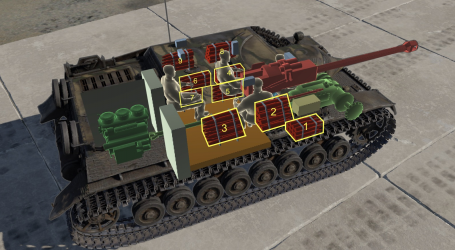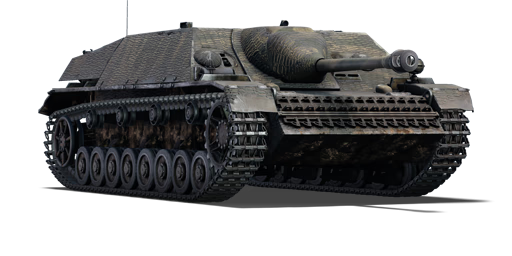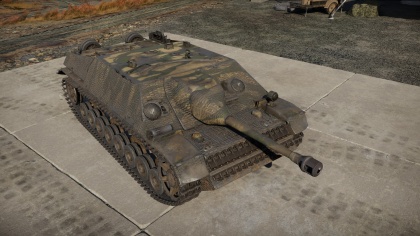Jagdpanzer IV
Contents
Description
The Jagdpanzer IV, German armoury designation Sd.Kfz. 162, is a rank III German tank destroyer
with a battle rating of 4.7 (AB) and 4.3 (RB/SB). It was introduced in during the Closed Beta Test for Ground Forces before Update 1.41.
General info
Survivability and armour
Armour type:
- Rolled homogeneous armour (Hull, Superstructure)
- Cast homogeneous armour (Gun mantlet)
| Armour | Front (Slope angle) | Sides | Rear | Roof |
|---|---|---|---|---|
| Hull | 60 mm (47°) Upper glacis 50 mm (55°) Lower glacis |
30 mm (12-48°) + 5 mm (29°) Top 30 mm Bottom |
22 mm (15°) | 20 mm (6°) Front 20 mm (2°) Rear |
| Superstructure | 60 mm (50°) Front glacis 75 mm (conical) Gun mantlet 80 mm (spherical) Gun mount 120 mm (50°) Gun mount frame |
30 mm (29°) | 30 mm (31°) | 20 mm 60 mm Gun mount |
Notes:
- Suspension wheels and bogies are 15 mm thick while tracks are 20 mm thick.
- The Add-on Armor module adds tracks on the front and sides of the superstructure and the front hull.
- Mudguards are 4 mm thick.
The Jagdpanzer IV has a very vulnerable front hull, which can be penetrated easily by most guns at the battle rating. The fact that the transmission is mounted directly behind the front glacis means that any shot will disable it. It can be a double-edged sword: the transmission will soak up most shots which can be good at long range, but at close range it is a death sentence, as it allows your enemy to casually flank to your vulnerable sides and take out your whole crew.
Mobility
| Game Mode | Max Speed (km/h) | Weight (tons) | Engine power (horsepower) | Power-to-weight ratio (hp/ton) | ||||
|---|---|---|---|---|---|---|---|---|
| Forward | Reverse | Stock | AoA | Stock | Upgraded | Stock | Upgraded | |
| Arcade | 44 | 9 | 24 | 0.46 | 426 | 572 | 17.72 | 23.35 |
| Realistic | 40 | 8 | 265 | 300 | 11.02 | 12.24 | ||
Armaments
Main armament
| 75 mm PaK39 L48 | Turret rotation speed (°/s) | Reloading rate (seconds) | |||||||||||
|---|---|---|---|---|---|---|---|---|---|---|---|---|---|
| Mode | Capacity | Vertical | Horizontal | Stabilizer | Stock | Upgraded | Full | Expert | Aced | Stock | Full | Expert | Aced |
| Arcade | 79 | -8°/+15° | ±12° | N/A | 7.04 | 9.75 | __.__ | __.__ | 13.93 | 7.67 | _.__ | _.__ | 5.90 |
| Realistic | 4.76 | 5.60 | __.__ | __.__ | 8.00 | ||||||||
Although exemplary on the StuG III F and solid on the StuG III G at lower battle ratings, the PaK39 will find itself coming up short at the Jagdpanzer IV's BR. Compared to analogue 75 & 76 mm cannons, the PaK39 comes last in both ballistic performance and muzzle velocity. The increased armour of 4.7 also means that the now average PaK39 will have significantly more difficulty dealing with heavily armoured vehicles, namely the M4A3E2 Jumbo and Churchill VII.
To compensate for these shortcomings, tanks mounting the PaK39 are able to use the PzGr 40 APCR shell which offers an increased penetration power at point blank range. Although lacking in significant post-penetration damage, using the APCR could mean the difference between disabling a vehicle and bouncing a shell. Tankers should always carry at least a few PzGr 40 shells in case they run into a vehicle that would give the stock PzGr 39 trouble.
Ammunition
The available ammunition allows for engaging all types of targets:
- PzGr 39: APCBC; a shell with explosive filler but an average penetration power. It will destroy any tank it penetrates and should be the main ammunition used in battle. Few enemies will be able to withstand this shell but follow-up shots may be needed occasionally.
- PzGr 40: APCR; a composite round with the best penetration but no explosive filler and that will only penetrate flat vertical surfaces. Pack a few of these shells to use against heavily armoured foes that the PzGr 39 can't penetrate, or when sniping as the higher shell velocity makes aiming at moving targets easier.
- Hl.Gr 38B: HEAT; a shaped charge with mediocre penetration but without penetration loss over distance. It penetrates only flat vertical surfaces but the post-penetration damage is very effective on open and lightly armoured vehicles. It is however a very slow shell travelling around twice slower than your other projectiles.
- Sprgr. 34: HE; useful for destroying open and lightly armoured vehicles but slow shell.
- K.Gr.Rot Nb.: Smoke; useful to blind enemy vehicles that are too remote for you to disable so that you can progress towards objectives but slow shell.
| Penetration statistics | |||||||
|---|---|---|---|---|---|---|---|
| Ammunition | Type of warhead |
Penetration @ 0° Angle of Attack (mm) | |||||
| 10 m | 100 m | 500 m | 1,000 m | 1,500 m | 2,000 m | ||
| PzGr 39 | APCBC | 140 | 137 | 125 | 112 | 100 | 89 |
| PzGr 40 | APCR | 166 | 162 | 146 | 128 | 112 | 98 |
| Hl.Gr 38B | HEAT | 80 | 80 | 80 | 80 | 80 | 80 |
| Sprgr. 34 | HE | 10 | 10 | 10 | 10 | 10 | 10 |
| Shell details | |||||||||
|---|---|---|---|---|---|---|---|---|---|
| Ammunition | Type of warhead |
Velocity (m/s) |
Projectile Mass (kg) |
Fuse delay (m) |
Fuse sensitivity (mm) |
Explosive Mass (TNT equivalent) (g) |
Ricochet | ||
| 0% | 50% | 100% | |||||||
| PzGr 39 | APCBC | 750 | 6.8 | 1.3 | 15.0 | 28.9 | 48° | 63° | 71° |
| PzGr 40 | APCR | 930 | 4.2 | N/A | N/A | N/A | 66° | 70° | 72° |
| Hl.Gr 38B | HEAT | 450 | 4.4 | 0.0 | 0.1 | 872.1 | 62° | 69° | 73° |
| Sprgr. 34 | HE | 550 | 5.7 | 0.1 | 0.1 | 686 | 79° | 80° | 81° |
| Smoke shell characteristics | ||||||
|---|---|---|---|---|---|---|
| Ammunition | Velocity (m/s) |
Projectile Mass (kg) |
Screen radius (m) |
Screen deploy time (s) |
Screen hold time (s) |
Explosive Mass (TNT equivalent) (g) |
| K.Gr.Rot Nb. | 540 | 6.2 | 13 | 5 | 20 | 50 |
Ammo racks

| Full ammo |
1st rack empty |
2nd rack empty |
3rd rack empty |
4th rack empty |
5th rack empty |
6th rack empty |
7th rack empty |
8th rack empty |
9th rack empty |
Visual discrepancy |
|---|---|---|---|---|---|---|---|---|---|---|
| 79 | 71 (+8) | 62 (+17) | 53 (+26) | 44 (+35) | 35 (+44) | 26 (+53) | 17 (+62) | 9 (+70) | 1 (+78) | Yes |
Notes:
- Pack 26 (+53) shells to go into battle with the left flank ammunition depleted (racks 1 to 6 emptied).
- The visual discrepancy concerns the number of shells per rack as well as the total number of sells (73 shells modeled for 79 available).
- Rack 1 is modeled as 3 shells, racks 2, 3, 7 & 8: 10 shells, racks 4 & 5: 8 shells, rack 6: 6 shells and rack 9: 11 shells.
- However, racks 1 to 7 contain 9 shells each while racks 8 and 9 contain 8 shells each.
Machine guns
| 7.92 mm MG42 | ||||
|---|---|---|---|---|
| Mount | Capacity (Belt) | Fire rate | Vertical | Horizontal |
| Hull mount | 1200 (150) | 1200 | -5°/+13° | ±5° |
The Jagdpanzer IV has a MG42 machine gun. Since it is mounted on the hull, it cannot effectively shoot at planes. However, it does have a higher fire rate, making it useful for gunning down lightly armoured vehicles.
Usage in battles
As with every casemate tank destroyer, getting flanked will usually result in death. The only true way to use this tank to its ultimate advantage is to stay as far away from the battle as possible and stay perched high up. If the Jagdpanzer IV finds itself fighting at close range, keep its flanks protected, hide while reloading and don't miss any shots.
A very effective tactic is to move to the corner of a building, preferably facing down a road or area that the enemy will likely frequent. The Jagdpanzer IV can then peek around the corner, where its frontal armour will be angled, but the rear and side armour will not be exposed to the enemy. This makes the tank destroyer very difficult to penetrate. Most enemy rounds will bounce or cause minimal damage.
Modules
| Tier | Mobility | Protection | Firepower | ||
|---|---|---|---|---|---|
| I | Tracks | Ostketten | Parts | Horizontal Drive | |
| II | Suspension | Brake System | FPE | Hl.Gr 38B | Adjustment of Fire |
| III | Filters | Crew Replenishment | PzGr 40 | Elevation Mechanism | |
| IV | Transmission | Engine | Add-on Armor | K.Gr.Rot Nb. | Smoke Grenade |
Pros and cons
Pros:
- Very comfortable to drive thanks to the fair acceleration & top speed
- Excellent gun traverse arc to each side gives the ability to shot while having the tank angled
- Low profile, not an easy target at long ranges
- Can load APCR to help with heavier tanks
- Frontal armour is well sloped and can mount tracks to improve protection
Cons:
- Vulnerable sides
- Will often face vehicles that can punch through its armour frontally
- PaK39 is lacking compared to enemy armaments
- Prone to ammo rack detonation
- As with most casemates, a dead transmission or driver means a dead vehicle
- Small vehicle, if it gets penetrated all the crew can be knocked out in one hit
History
Development
In September 1942, the Wehrmacht arms bureau called for a new type of assault vehicles. The specifications listed was 100 mm front armour, 40-50 mm on the sides, wide tracks, a top speed of 26 km/h, ground clearance of 50 cm, and a very low firing position. The design was to be armed with the 75 mm Pak 42 mounted on the Panther tanks. Though this project was originally conceived over a completely new chassis, the Panzer IV was chosen to be used instead. The design was to have a low silhouette and an enclosed casemate fighting compartment after experiences with the Marder IIIs showed that such features were necessary for a successful fighting vehicle.
The Panzer IV chassis was converted into the Jagdpanzer IV, which featured new designs to the original. The utilization of the Panzer IV chassis was met with much criticism by General Heinz Guderian, who saw the diverting of Panzer IV tank resources as unnecessary since the current assault gun StuG III was more than adequate in the role and Germany still needed reliable tanks that it could use. The vertical front hull armour was replaced with large sloped armour plates, ammunition and fuel were moved to accommodate the new superstructure design, and the auxiliary engine that once powered the Panzer IV turret was removed. The superstructure had 80 mm thick sloping armour that gives it an effective 100 mm thick. To simplify the production of this vehicle, the superstructure was essentially made of large interlocking plates that are welded together. The vehicle had a crew of four, the commander, gunner, loader, and driver. The vehicle was armed with a 75 mm gun, though originally suppose to be the one from the Panther, shortages forced the mounting of older guns such as the 75 mm Pak 39 L/48 cannon, which were less powerful than the Panther's PaK 42, but were still lethal. Due to the different gun mounts, three main variants were produced from the Jagdpanzer IV, the original Jagdpanzer IV (with the 75 mm Pak 39 L/48 cannon), the Panzer IV/70 (V), and the Panzer IV/70 (A) (Both of which have the 75 mm Pak 42 L/70 cannon).
The Jagdpanzer IV, mounting the 75 mm Pak 39, was designed and produced by Vomag. It was produced from January to November 1944 with about 769 units produced. The early version had a muzzle brake and zimmerit anti-magnetic paste added to the vehicle. However, the muzzle brake was removed as it kicks up a large amount of dust from the ground that obscures the gunner's sights so that was removed, and the zimmerit was also removed after September 1944 due to rumours that they were causing vehicle fires. Other modifications were made to the design over time, but the biggest change in its production was the addition of Schürzen side armour plates.
Combat usage
The Jagdpanzer IV (the name was interchangeable between all of its variants) was first issued on March 1944 and was employed in an anti-tank role in the Western and Eastern Front. The Jagdpanzer IV participated in the Normandy Campaign, Battle of the Bulge, and the Soviet Offensives on the Eastern Front. Their overall performance was very successful as tank destroyers and only sub-par in other roles that are usually taken by tanks or assault guns, as the high-velocity 75 mm cannon it mounts were unsuitable for anti-infantry and fortification purposes. However, they were soon put in positions of tanks due to shortages of capable fighting vehicles in German inventory. One of the popular Jagdpanzer IV aces was SS-Oberscharführer Rudolf Roy who was attached to the 12th SS Tank Destroyer Battalion. He was killed while looking out of his Jagdpanzer IV hatch during the Battle of the Bulge.
After World War II ended, the Jagdpanzer IV's design still saw service with the German Bundeswehr as the Hanomag-Henschel JPz 4-5|Kanonenjagdpanzer, which has the nearly same design as the Jagdpanzer IV, but most notably with a 90 mm gun. Some captured Jagdpanzer IVs were given out by the Soviet Union to Romania and Syria, but Romania scrapped all the German armour by 1954 and Syria used them in conflicts against Israel until 1967.
In-game description
"This self-propelled gun was developed in 1943 to strengthen German anti-tank defensive capabilities. A very low, welded hull was placed on the Pz.Kpfw. IV's chassis, with reasonably-sloped front and side armor plates. This way, the front armor was almost 50% thicker than the tank's base model. The combat and control crew compartments were located in the front, and the engine was in the rear. The tank destroyer was armed with a 75 mm 7,5cm Pak39 L/48 anti-tank gun with a long 48 caliber barrel, mounted in the combat crew compartment. On the exterior, the gun was covered by a massive, cast mantlet. To enhance the armor protection on the sides of the self-propelled vehicle, additional Schurzen side skirts were added. Self-propelled anti-tank guns released before September 1944 had anti-magnetic Zimmerit paste applied to their vertical surfaces. Vomag AG factories released 769 of these vehicles from January to October 1944.
In August 1944, vehicles began to be produced with the 75 mm 7.5 cm KwK. 42 L/70 gun, similar to the gun installed on the Panther tank. This transition passed smoothly, and production of Jagdpanzer IV tanks with the shorter guns gradually tapered off.
This tank destroyer enjoyed great popularity with tank troops, since its gun could knock out virtually any Allied tank of its day. This anti-tank gun fought with anti-tank divisions on all fronts.
The generally successful vehicle had a number of shortcomings. Its front armor was 60 mm thick, resulting in the loss of a number of vehicles. However, increasing the thickness to 80 mm shifted the vehicle's center of gravity, overloading the front pair of road wheels, which were prone to fail."
Media
- Skins
- Videos
See also
- Vehicles equipped with the same chassis
- Vehicles equipped with the same gun
- Other vehicles of similar configuration and role
External links
- [Wikipedia] Jagdpanzer IV
- [Tanks Encyclopedia] Jagdpanzer IV
- [Military Factory] SdKfz 162 Jagdpanzer IV (Panzerjager 39)
| Germany tank destroyers | |
|---|---|
| Pz. I Derivatives | Panzerjäger I |
| Pz. II Derivatives | 15cm sIG 33 B Sfl |
| Pz. 38(t) Derivatives | Marder III · Marder III H · Jagdpanzer 38(t) |
| Pz. III Derivatives | StuG III A · StuG III F · StuG III G · StuH 42 G |
| Pz. IV Derivatives | Jagdpanzer IV · Panzer IV/70(A) · Panzer IV/70(V) · Dicker Max · Nashorn · Brummbär · VFW |
| Pz. V Derivatives | Jagdpanther G1 · Bfw. Jagdpanther G1 |
| Pz. VI Derivatives | Sturer Emil · Elefant · Ferdinand · 38 cm Sturmmörser · Jagdtiger |
| Wheeled/Half-track | 8,8 cm Flak 37 Sfl. · Sd.Kfz.251/9 · Sd.Kfz.251/10 · Sd.Kfz.251/22 · Sd.Kfz.234/3 · Sd.Kfz.234/4 · 15 cm Pz.W.42 |
| ATGM Carrier | RakJPz 2 · RakJPz 2 (HOT) · Wiesel 1A2 |
| Other | Waffenträger · M109G · JPz 4-5 · Raketenautomat · VT1-2 |





